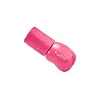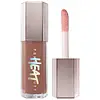What's inside
What's inside
 Key Ingredients
Key Ingredients

 Benefits
Benefits

 Concerns
Concerns

 Ingredients Side-by-side
Ingredients Side-by-side

Diisostearyl Malate
EmollientHydrogenated Polyisobutene
EmollientTridecyl Trimellitate
EmollientPentaerythrityl Tetraisostearate
EmollientSilica Dimethyl Silylate
EmollientSorbitan Isostearate
EmulsifyingSynthetic Wax
Abrasive1,2-Hexanediol
Skin ConditioningDisteardimonium Hectorite
StabilisingTocopheryl Acetate
AntioxidantCI 77891
Cosmetic ColorantPropylene Carbonate
SolventParfum
MaskingCI 15850
Cosmetic ColorantCI 45410
Cosmetic ColorantCI 19140
Cosmetic ColorantCI 15985
Cosmetic ColorantLinalool
PerfumingLimonene
PerfumingGeraniol
PerfumingSimmondsia Chinensis Seed Oil
EmollientPrunus Amygdalus Dulcis Oil
Skin ConditioningPrunus Armeniaca Kernel Oil
MaskingOenothera Biennis Oil
EmollientOlea Europaea Fruit Oil
MaskingArgania Spinosa Kernel Oil
EmollientButyrospermum Parkii Butter
Skin ConditioningCamellia Japonica Seed Oil
EmollientCaprylic/Capric Triglyceride
MaskingMangifera Indica Fruit Extract
Skin ConditioningRosa Canina Fruit Extract
AstringentAnemarrhena Asphodeloides Root Extract
Skin ConditioningTocopherol
AntioxidantDiisostearyl Malate, Hydrogenated Polyisobutene, Tridecyl Trimellitate, Pentaerythrityl Tetraisostearate, Silica Dimethyl Silylate, Sorbitan Isostearate, Synthetic Wax, 1,2-Hexanediol, Disteardimonium Hectorite, Tocopheryl Acetate, CI 77891, Propylene Carbonate, Parfum, CI 15850, CI 45410, CI 19140, CI 15985, Linalool, Limonene, Geraniol, Simmondsia Chinensis Seed Oil, Prunus Amygdalus Dulcis Oil, Prunus Armeniaca Kernel Oil, Oenothera Biennis Oil, Olea Europaea Fruit Oil, Argania Spinosa Kernel Oil, Butyrospermum Parkii Butter, Camellia Japonica Seed Oil, Caprylic/Capric Triglyceride, Mangifera Indica Fruit Extract, Rosa Canina Fruit Extract, Anemarrhena Asphodeloides Root Extract, Tocopherol
Polybutene
Octyldodecanol
EmollientBis-Diglyceryl Polyacyladipate-2
EmollientTricaprylin
MaskingCera Microcristallina
Emulsion StabilisingHydrogenated Polyisobutene
EmollientPolyethylene
AbrasiveSilica Dimethyl Silylate
EmollientButyrospermum Parkii Butter
Skin ConditioningVp/Eicosene Copolymer
Sorbitan Oleate
EmulsifyingVp/Hexadecene Copolymer
Silica
AbrasiveEthylhexyl Palmitate
EmollientCaprylyl Glycol
EmollientAroma
Parfum
MaskingOctyldodecyl Neopentanoate
EmollientButyrospermum Parkii Butter Unsaponifiables
Skin ConditioningTribehenin
EmollientMica
Cosmetic ColorantPentaerythrityl Tetra-Di-T-Butyl Hydroxyhydrocinnamate
AntioxidantMethyl Nicotinate
SoothingSorbitan Isostearate
EmulsifyingTocopherol
AntioxidantTocopheryl Acetate
AntioxidantVanillyl Butyl Ether
MaskingCapsicum Frutescens Fruit Extract
Skin ConditioningGlycine Soja Oil
EmollientZingiber Officinale Root Oil
MaskingSynthetic Fluorphlogopite
Tetrahexyldecyl Ascorbate
AntioxidantLactic Acid
BufferingCalcium Sodium Borosilicate
Calcium Aluminum Borosilicate
Palmitoyl Tripeptide-1
Skin ConditioningTin Oxide
AbrasiveBenzyl Benzoate
AntimicrobialLimonene
PerfumingIron Oxides
CI 15850
Cosmetic ColorantCI 77891
Cosmetic ColorantPolybutene, Octyldodecanol, Bis-Diglyceryl Polyacyladipate-2, Tricaprylin, Cera Microcristallina, Hydrogenated Polyisobutene, Polyethylene, Silica Dimethyl Silylate, Butyrospermum Parkii Butter, Vp/Eicosene Copolymer, Sorbitan Oleate, Vp/Hexadecene Copolymer, Silica, Ethylhexyl Palmitate, Caprylyl Glycol, Aroma, Parfum, Octyldodecyl Neopentanoate, Butyrospermum Parkii Butter Unsaponifiables, Tribehenin, Mica, Pentaerythrityl Tetra-Di-T-Butyl Hydroxyhydrocinnamate, Methyl Nicotinate, Sorbitan Isostearate, Tocopherol, Tocopheryl Acetate, Vanillyl Butyl Ether, Capsicum Frutescens Fruit Extract, Glycine Soja Oil, Zingiber Officinale Root Oil, Synthetic Fluorphlogopite, Tetrahexyldecyl Ascorbate, Lactic Acid, Calcium Sodium Borosilicate, Calcium Aluminum Borosilicate, Palmitoyl Tripeptide-1, Tin Oxide, Benzyl Benzoate, Limonene, Iron Oxides, CI 15850, CI 77891
 Reviews
Reviews

Ingredients Explained
These ingredients are found in both products.
Ingredients higher up in an ingredient list are typically present in a larger amount.
This ingredient is also known as shea butter. It is an effective skin hydrator and emollient.
Emollients help soothe and soften your skin. It does this by creating a protective film on your skin. This barrier helps trap moisture and keeps your skin hydrated. Emollients may be effective at treating dry or itchy skin.
Shea butter is rich in antioxidants. Antioxidants help fight free-radicals, or molecules that may harm the body. It is also full of fatty acids including stearic acid and linoleic acid. These acids help replenish the skin and keep skin moisturized.
While Shea Butter has an SPF rating of about 3-4, it is not a sunscreen replacement.
Shea butter may not be fungal acne safe. We recommend speaking with a professional if you have any concerns.
Learn more about Butyrospermum Parkii ButterCi 15850 is the pigment color red. It is an azo dye and created synthetically.
Azo dyes need to be thoroughly purified before use. This allows them to be more stable and longer-lasting.
This ingredient is common in foundations, lipsticks, and blushes. This color is described as brown/orangey red.
It has many secondary names such as Red 6 and Red 7. According to a manufacturer, Red 6 usually contains aluminum.
Learn more about CI 15850Ci 77891 is a white pigment from Titanium dioxide. It is naturally found in minerals such as rutile and ilmenite.
It's main function is to add a white color to cosmetics. It can also be mixed with other colors to create different shades.
Ci 77891 is commonly found in sunscreens due to its ability to block UV rays.
Learn more about CI 77891Hydrogenated Polyisobutene is a synthetic polymer. Polymers are compounds with high molecular weight. Hydrogenated Polyisobutene is an emollient and texture enhancer.
In one study, Hydrogenated Polyisobutene showed better skin hydration levels than Caprylic/Capric Triglyceride. As an emollient, it helps keep your skin soft and hydrated by trapping moisture in.
Hydrogenated Polyisobutene is often used as a mineral oil replacement.
Learn more about Hydrogenated PolyisobuteneLimonene is a fragrance that adds scent and taste to a formulation.
It's found in the peel oil of citrus fruits and other plants such as lavender and eucalyptus. The scent of limonene is generally described as "sweet citrus".
Limonene acts as an antioxidant, meaning it helps neutralize free radicals.
When exposed to air, oxidized limonene may sensitize the skin. Because of this, limonene is often avoided by people with sensitive skin.
The term 'fragrance' is not regulated in many countries. In many cases, it is up to the brand to define this term. For instance, many brands choose to label themselves as "fragrance-free" because they are not using synthetic fragrances. However, their products may still contain ingredients such as essential oils that are considered a fragrance.
Learn more about LimoneneParfum is a catch-all term for an ingredient or more that is used to give a scent to products.
Also called "fragrance", this ingredient can be a blend of hundreds of chemicals or plant oils. This means every product with "fragrance" or "parfum" in the ingredients list is a different mixture.
For instance, Habanolide is a proprietary trade name for a specific aroma chemical. When used as a fragrance ingredient in cosmetics, most aroma chemicals fall under the broad labeling category of “FRAGRANCE” or “PARFUM” according to EU and US regulations.
The term 'parfum' or 'fragrance' is not regulated in many countries. In many cases, it is up to the brand to define this term.
For instance, many brands choose to label themselves as "fragrance-free" because they are not using synthetic fragrances. However, their products may still contain ingredients such as essential oils that are considered a fragrance by INCI standards.
One example is Calendula flower extract. Calendula is an essential oil that still imparts a scent or 'fragrance'.
Depending on the blend, the ingredients in the mixture can cause allergies and sensitivities on the skin. Some ingredients that are known EU allergens include linalool and citronellol.
Parfum can also be used to mask or cover an unpleasant scent.
The bottom line is: not all fragrances/parfum/ingredients are created equally. If you are worried about fragrances, we recommend taking a closer look at an ingredient. And of course, we always recommend speaking with a professional.
Learn more about ParfumThis silica is mainly used to thicken oils and suspend particles in oils. It is not water soluble.
According to the manufacturer, it:
The manufacturer also claims this ingredient to be useful in makeup.
In lipstick formulations, this ingredient improves color payoff, reduces pigment settling, and reduces oil bleeding. This ingredient also improves the grip of powder products such as dry shampoos.
Learn more about Silica Dimethyl SilylateSorbitan Isostearate is an emulsifer and cleaning agent. It is created from isostearic acid and sorbitol.
As an emulsifier, Sorbitan Isostearate prevents oils and water from separating.
Due to its isostearic acid base, it may not be safe for Malassezia or fungal acne.
Learn more about Sorbitan IsostearateTocopherol (also known as Vitamin E) is a common antioxidant used to help protect the skin from free-radicals and strengthen the skin barrier. It's also fat soluble - this means our skin is great at absorbing it.
Vitamin E also helps keep your natural skin lipids healthy. Your lipid skin barrier naturally consists of lipids, ceramides, and fatty acids. Vitamin E offers extra protection for your skin’s lipid barrier, keeping your skin healthy and nourished.
Another benefit is a bit of UV protection. Vitamin E helps reduce the damage caused by UVB rays. (It should not replace your sunscreen). Combining it with Vitamin C can decrease sunburned cells and hyperpigmentation after UV exposure.
You might have noticed Vitamin E + C often paired together. This is because it is great at stabilizing Vitamin C. Using the two together helps increase the effectiveness of both ingredients.
There are often claims that Vitamin E can reduce/prevent scarring, but these claims haven't been confirmed by scientific research.
Learn more about TocopherolTocopheryl Acetate is AKA Vitamin E. It is an antioxidant and protects your skin from free radicals. Free radicals damage the skin by breaking down collagen.
One study found using Tocopheryl Acetate with Vitamin C decreased the number of sunburned cells.
Tocopheryl Acetate is commonly found in both skincare and dietary supplements.
Learn more about Tocopheryl Acetate